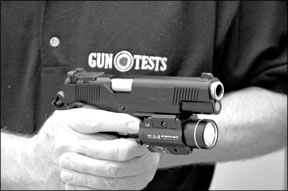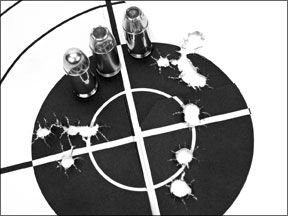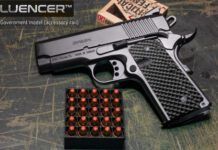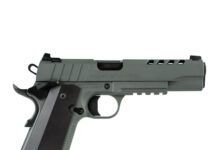Once again we are responding to a subscriber by filling out a test roster with pistols suggested by reader mail. The category requested was full-size single-action-only semi-automatic pistols chambered for .45 ACP and framed with a built-in accessory rail for attaching a light or laser.
We got 1911-style pistols from Kimber and Springfield Armory along with a single-action-only version of the Sigarms P220R. The Kimber was a an $1113 Custom TLE RL II, essentially the model sold to LAPD SWAT.

Springfield Armorys $1740 TRP Light Rail Armory Kote is referred to on the manufacturers website as being “designed around the same specifications” as the companys FBI contract pistol.
The Sigarms P220 series was, from the beginning, designed for military use. Our $1013 P220R TSS SAO was probably developed to compete for the United States military contract that ultimately failed to materialize last year. Kimber and Springfield Armory have built their reputations producing 1911-style pistols, but for Sigarms the combination of a single-action trigger teamed with ambidextrous thumb safeties was a fresh approach. We couldnt wait to see how these single-stack pistols stacked up.
Each gun was tested from a sandbag rest backed by solid support from a distance of 25 yards. We measured five-shot groups printed with three different types of ammunition. They were Hornady Custom 185-grain XTP/JHP hollowpoints, Speer Gold Dot 200-grain GDHP +P hollowpoints, and Winchesters 230-grain USA FMJ round-nosed jacketed ammunition. The Winchester USA rounds were also used throughout our “practical” tests, which consisted mainly of pounding “Evil Roy,” steel plates from Action Target (actiontarget.com), punctuated by reloading as quickly as we could. Each gun digested about 350 rounds throughout our tests. Here is what we learned.
Springfield Armory TRP
Light Rail Armory Kote
PC9105LP .45 ACP, $1740
The most expensive pistol in the test also had the most features. Not only did the TRP Light Rail Armory Kote have a special black-Teflon finish, but also a magazine guide matched to the beveled magazine well. The grips were a gray composite material referred to as G10 that offered unique ridges and a contour on the left-side panel to help guide the thumb to the release.

The front strap offered the cleanest checkering of our test guns at 20 lpi. The mainspring housing on the rear of the receiver was also checkered at 20 lpi and was flat in profile. The grip safety was mounted high and deep into the frame. As a result, the TRP locked into our hands.
The slide was cut with cocking serrations front and rear, and the adjustable rear sight was blended low into the top strap. Based on the Bo-Mar design, the assembly looked very rugged and was sunk deeply into the slide for maximum protection. Night-sight tritium modules were inlaid front and rear, but we would have preferred that they were larger. The ambidextrous thumb safeties and the lightweight hammer were dark with only the trigger, heavy guide rod and bull barrel showing a silvery finish.
The guide rod was a one-piece model that ran through a reverse plug, which is like a sleeve seated into the front of the slide. Field-stripping required first removing the entire top end. The slide stop pin was shorter than we typically find. This is to prevent the pin from being pressed out unintentionally. It is not uncommon for operators to index their trigger finger along the frame until they have a target and engage the trigger. Undue pressure on the slide-stop pin can force the gun out of battery as the stop passes the release notch. But there was enough of the pin exposed so that it could be pushed in with a bare finger, making it possible to pull the slide stop out from the other side.
With the top end off, we held the slide upside down and shoved the guide rod forward to expose a small hole drilled into the rod about halfway to the tip. Here you must insert a pin to capture the reverse plug and the recoil spring. A pin was supplied, but we found it to be too long to fit through the slide loop. We substituted a smaller L-shaped wire fashioned from a large paperclip. But the narrow gauge of the wire did not compress the spring enough. We were able to remove the guide rod assembly by pulling on the reverse plug so that it compressed the spring enough to let the bulk of the reverse plug pass through the slide.
A capturing pin can always be improvised, but were not sure wed like to be on a battlefield with this type of arrangement. Then again, civilians will rarely be so indisposed.
Fortunately, the Springfield Armory TRP ran like a tank and fed every type of ammunition we could find, including lead semi-wadcutters fired from 10-round magazines that stuck out from the receiver. Not to our liking, the TRP was shipped with seven-round magazines.
The 2-inch-long Springfield Armory rail offered three lugs. We tried mounting a Surefire X200, which slides on, and also a Stream Light TLR-2 that clips on from underneath while pressing the spring-loaded set screw. The X200 required the “P” for Picatinny cross plate be in place. The TLR-2 was fixed using finger pressure turning the set screw. Release was via backing off the set screw and pressing it inward. Both units went on and off the Springfields rail like they were made for it.
From the bench our Springfield TRP produced groups that averaged about 2.0 inches across with all rounds tested. This is very good accuracy and also a satisfying level of predictability. But it was not the best among our test pistols. Our test shooters reported that the narrow front sight left more light between the sides of the blade than they were used to, and that the trigger was not as clean or as crisp as they would have liked. These traits made them work harder for accuracy.
But the extra peripheral vision afforded by the sight seemed to pay off when mounting the gun from a draw and moving from target to target. Standing and shooting, we felt the way the gun fit our hands offered the best control among our three pistols.
The TRP also did the best job of absorbing recoil. This could be attributed to it being the heaviest pistol in the test. More important, it packed the most weight below the bore line. The frame of the Kimber weighed in at about 17.7 ounces. The Springfield frame weighed almost 4 ounces more. (The difference in total weight between our two 1911s was more than 5 ounces.)
During our rapid-fire tests, the TRP was the most eager to accept a fast reload. Naturally, this was due to the magazine guide. But we felt reloads could have been even easier if the rear corner of the magazine well and magazine guide had been blended further to produce a bowl-like shape, such as those found on IPSC competition guns.
Kimber Custom
TLE RL II .45 ACP, $1113
In visiting the kimberamerica.com website, we noticed some crossover regarding the Custom TLE II and the Custom TLE RL II.
The TLE II is specifically referred to as “identical to the pistol selected by LAPD SWAT for duty carry.” The model shown was devoid of an accessory rail, but under specifications, the text reads that a tactical rail is available on some models. That would be our test pistol, the Custom TLE RL II.
Save for the barrel, trigger, guide rod, and sides of the hammer, the TLE RL II was finished in a matte-black oxide. We prefer to call it all-business black. The steel frame featured 30-lpi checkering on the mainspring housing and 30-lpi checkering on the front strap.
The front strap of the Kimber was slightly broader than that of the Springfield Armory pistol. The grip safety did not have a raised surface, but we never grabbed the gun without it compressing smoothly. This is important because the firing-pin safety on the series II Kimber pistols are controlled by the grip safety. Inadequate compression will leave the gun unable to fire.
The TLE RL II also uses the traditional internal mounting of the extractor, that in the opinion of many professionals is more durable than external mounting found on other Kimber models.
The Kimber utilized a straight barrel with bushing lockup. Actually, the section of barrel that locked into bushing was faintly larger in outer diameter to enhance lockup. The steel guide rod was long but cut a little short of completely filling the recoil spring plug. This made it easier to apply the bushing wrench for disassembly. The slide-stop pin was full length across the frame.
Just as found on the Springfield pistol, most operators prefer that this pin be shorter so that it seats flush or nearly flush with the frame. This avoids accidentally pushing it through and jamming the pistol. The hole in the frame for the pin was beveled inward, so grinding the cross pin flush with the frame would still allow for it to be pushed through without using a punch.
The 1.8-inch-long rail on the dustcover offered three lugs and was sculpted to keep weight at a minimum. Application of our Stream Light and Surefire lights was quick, easy, and sure.
Cocking serrations were found fore and aft upon the slide. Big, highly visible Meprolight night sights appeared front and rear. The rear unit was adjustable for windage only via drift. A change in elevation would require changing the front sight, which was dovetailed into place. The big front dot can tempt shooters to use the top of the dot and not the top of the front sight blade to set elevation in their sight picture. We noticed that doing so caused the point of impact to jump up as much as 3 inches at 25 yards.
The Kimber pistol did not have as many features as the Springfield Armory TRP, and this kept the price much lower. The thumb safety was left side only. We would have preferred an ambidextrous set of paddles. The grip panels were rubber. Rubber can be more comfortable but it may become slippery when wet. Personal preference in most cases will likely dictate a change in size and texture anyway.
The magazine well was not enhanced with a magazine guide, but it was generously beveled. The Kimber was shipped with one flush-fit seven-round magazine and two eight-round Kim-Pro magazines. The Kim-Pro mags were rebuildable and featured removable, oversized basepads.
At the bench the TLE RL II shot groups that computed to an overall average size of 1.8 inches across. A single sub-1-inch group was achieved firing the Winchester USA ammunition. We saw the widest variation in group size firing the Speer Gold Dot 200-grain +P ammunition. But this was typical of all three test pistols. Firing this high-pressure ammunition provided a wake-up call to the shooter, demanding that he pay attention to grip and follow through.
Despite a lapse in concentration that produced a 2.6-inch group, the Kimber TLE RL II averaged 1.8 inches with the hot GDHP ammunition. In the heat and humidity of South Texas, we tried changing from the rubber grips to Hogues checkered aluminum grip panels. This simple fix helped us shoot the TLE RL II more aggressively in our tests.
Sigarms P220R TSS SAO
.45 ACP, $1013
Until recently, the Sigarms P220 series pistol was only available with a traditional double action or, TDA, trigger. This meant the first trigger pull would both draw back and release the hammer. Movement of the slide would leave the hammer back so that subsequent trigger presses only served to release the hammer. The hammer could be thumbed back to bypass the longer double action pull, but for safe carry a decocker was supplied to lower the hammer without impacting the firing pin.
More recently, Sigarms developed the DAK trigger wherein all shots were delivered double action. But for anyone who has fired a Sigarms pistol, the desire has always been for all shots to be fired single action. In the P220R SAO variation, the shooter gets his wish.
Instead of a decocker the SAO models feature a thumb safety on both sides of the frame. The magazine button can be changed to operate from the right side, so save for the slide release, the P220R SAO is left-hand friendly. Actually, the ambidextrous thumb paddles assure that the gun can be drawn and fired by either hand without compromising safety.
Our single-action pistol was a two-tone model. The frame had a hard-coat-anodized alloy construction with a three-lug 1.6-inch rail. Both our Stream Light TLR-2 and our Surefire X200 fit the Sigarms rail with ease. In the case of the X200, either the “U” (universal) or the “P” (Picatinny) cross plates fit our P220R.
The slide was machined from stainless steel bar stock and finished in its natural color. The addition of night sights raised the suggested retail price from $947 to $1013. The grips were plastic, and they wrapped completely around the backstrap, leaving only the undercut of the frame showing through. The front strap was left smooth. The grips added a sizeable arch toward the bottom. With the panels removed, we noticed that the shape of the frame did not necessarily require the grip to form a palm swell. But at the top of the grip where the panels cut inward beneath the beavertail, the plastic was right up against the mainspring. Many shooters have found it difficult to balance a firm grip with the long double-action first shot of the TDA P220 pistols. All of our shooters found the SAO trigger much easier to shoot.
Underneath the grips, the Sigarms design appeared to be more complex and fragile than our two 1911s. Wires, springs, and transfer bars were visible. Nonetheless, the P220R is a proven commodity.
Our pistol utilized an extractor mounted inside the beefy slide. Removing the top end was much simpler than the 1911s. Lock back the slide, turn the frame-mounted latch 90 degrees, release the slide and the top end was free. There were no tools or pins necessary, and nothing remained separated from the two main pieces. The one-piece guide rod was surrounded by a multi-filament wire spring and the barrel simply lifted out.
The P220R TSS SAO arrived with two eight-round magazines. Aftermarket magazines for this model are limited, but Sigarms does offer 10-round magazines for $45.
Trigger-pull weight measured 1.5 to 2.5 pounds heavier than our other pistols. But since the trigger worked on a hinge, it had greater leverage, helping the shooter overcome the resistance. The difference between the 1911 single-action trigger and the hinged single-action trigger was not unlike the difference between a single-stage rifle and a two-stage rifle trigger. Our staff reported greater opportunity to steer the sights throughout the trigger press. But the hinged trigger had a longer reset, leaving it up to shooter to work harder to deliver rapid multiple shots.
We also noticed that the Sigarms pistol produced more muzzle flip than our 1911-style pistols. Measuring from the center line of the bore down to the top of our hand, we determined that the P220R TSS SAO sat about 0.2 inches higher in the hand than when holding the Kimber or Springfield Armory pistols. Plus, the Sigarms is a linkless design. In the opinion of the gunsmiths we spoke to, the swinging link, such as in the 1911 design, dissipates energy.
But all of this is just nit-picking when you compare the weight of our all-steel 1911s and the alloy-framed Sigarms pistol. After handling the P220R TSS SAO, the TRP felt like a brick. The difference in weight between the Sig and the others was more than 10 ounces on average. The advantage here is that this makes the Sig much easier to carry.
Bear in mind that adding a light to the accessory rail would add weight right where it would do the most good in order to counteract recoil.
From the bench, the Sigarms pistol proved very forgiving. The sights were easy to follow, and the trigger was a pleasure to modulate. From support the Sigarms P220R TSS SAO was our top performer. The Sig was able to print a sub-1-inch group with the Winchester USA rounds and produce an overall average group measuring just 1.6 inches across.
Firing standing unsupported, we didnt feel hampered by the trigger. The longer stroke did not tempt us to dip the muzzle as we have found on many double-action pistols. Naturally, the heavier recoiling ammunition slowed us down. We found it easiest to shoot the Hornady 185-grain ammunition, which produced the least recoil of our test rounds. As expected, the shorter 4.5-inch barrel produced less velocity. Sight radius was more than adequate, however, making the sights easy to track.
TACTICAL_ACCURACY_CHRONO_0807.pdf




























